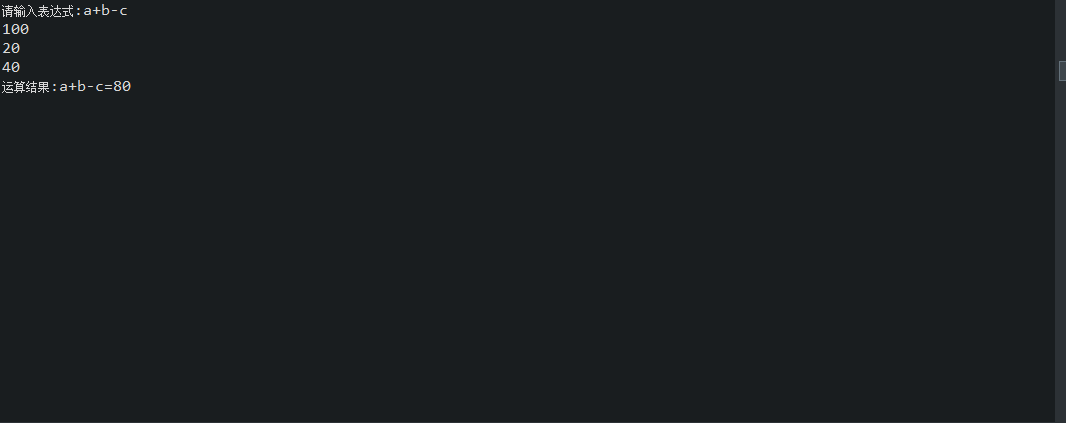解释器模式
什么是解释器模式??
举个例子
假设现在有一个业务需求如下:
输入一个模式公式(加减运算),然后输入模型中的参数,运算出结果。
设计要求:
1、公式可以运行时编辑,并且符合正常的算术书写方式。
2、高扩展性
抽象表达式类
1 package sehjimoshi.interpreter; 2 3 import java.util.HashMap; 4 5 /** 6 * <p>Description:</p> 7 * 8 * @author Administrator 9 * @date 2019年1月8日下午1:26:09 10 * @version 1.0 11 */ 12 public abstract class Expression { 13 // 解释公式和数值,其中的var中的key值是公式中的参数,value是具体的数值 14 public abstract int interpreter(HashMap<String,Integer> var); 15 }
变量解释器类
package sehjimoshi.interpreter; import java.util.HashMap; /** * <p>Description:</p> * * @author Administrator * @date 2019年1月8日下午1:28:13 * @version 1.0 */ public class VarExpression extends Expression { private String key; public VarExpression(String key) { this.key = key; } @Override public int interpreter(HashMap<String, Integer> var) { return var.get(this.key); } }
抽象运算符号解释器类
/** * */ package sehjimoshi.interpreter; /** * <p>Description:</p> * * @author Administrator * @date 2019年1月8日下午1:30:00 * @version 1.0 */ public abstract class SymbolExpression extends Expression { protected Expression left; protected Expression right; public SymbolExpression(Expression left, Expression right) { super(); this.left = left; this.right = right; } }
加法解释器类
1 /** 2 * 3 */ 4 package sehjimoshi.interpreter; 5 6 import java.util.HashMap; 7 8 /** 9 * <p>Description:</p> 10 * 11 * @author Administrator 12 * @date 2019年1月8日下午1:31:27 13 * @version 1.0 14 */ 15 public class AddExpression extends SymbolExpression { 16 17 18 public AddExpression(Expression left, Expression right) { 19 super(left, right); 20 21 } 22 23 @Override 24 public int interpreter(HashMap<String, Integer> var) { 25 return super.left.interpreter(var) + super.right.interpreter(var); 26 } 27 28 }
减法解释器类
1 /** 2 * 3 */ 4 package sehjimoshi.interpreter; 5 6 import java.util.HashMap; 7 8 /** 9 * <p>Description:</p> 10 * 11 * @author Administrator 12 * @date 2019年1月8日下午1:32:57 13 * @version 1.0 14 */ 15 public class SubExpression extends SymbolExpression { 16 17 18 public SubExpression(Expression left, Expression right) { 19 super(left, right); 20 21 } 22 23 24 @Override 25 public int interpreter(HashMap<String, Integer> var) { 26 return super.left.interpreter(var) - super.right.interpreter(var); 27 } 28 29 }
解释器封装类
1 /** 2 * 3 */ 4 package sehjimoshi.interpreter; 5 6 import java.util.HashMap; 7 import java.util.Stack; 8 9 /** 10 * <p>Description:</p> 11 * 12 * @author Administrator 13 * @date 2019年1月8日下午1:34:05 14 * @version 1.0 15 */ 16 public class Calculator { 17 // 定义表达式 18 private Expression expression; 19 20 public Calculator(String expStr) { 21 // 定义一个栈 22 Stack<Expression> stack = new Stack<Expression>(); 23 // 表达式拆分为数组 24 char[] charArray = expStr.toCharArray(); 25 26 // 运算 27 Expression left = null; 28 Expression right = null; 29 30 for (int i = 0; i < charArray.length; i++) { 31 switch (charArray[i]) { 32 case '+': 33 left = stack.pop(); 34 right = new VarExpression(String.valueOf(charArray[++i])); 35 stack.push(new AddExpression(left,right)); 36 break; 37 case '-': 38 left = stack.pop(); 39 right = new VarExpression(String.valueOf(charArray[++i])); 40 stack.push(new SubExpression(left, right)); 41 break; 42 default: 43 stack.push(new VarExpression(String.valueOf(charArray[i]))); 44 45 } 46 } 47 48 // 把运算结果抛出来 49 this.expression = stack.pop(); 50 } 51 52 /** 53 * 开始运算 54 */ 55 public int run(HashMap<String,Integer> var) { 56 return this.expression.interpreter(var); 57 } 58 }
客户端模拟类
1 /** 2 * 3 */ 4 package sehjimoshi.interpreter; 5 6 import java.io.BufferedReader; 7 import java.io.IOException; 8 import java.io.InputStreamReader; 9 import java.util.HashMap; 10 import java.util.Iterator; 11 12 /** 13 * <p>Description:</p> 14 * 15 * @author Administrator 16 * @date 2019年1月8日下午1:42:20 17 * @version 1.0 18 */ 19 public class Client { 20 21 /** 22 * @param args 23 * @throws IOException 24 */ 25 public static void main(String[] args) throws IOException { 26 // TODO Auto-generated method stub 27 String expStr = getExpStr(); 28 29 HashMap<String, Integer> var = getValue(expStr); 30 31 Calculator cal = new Calculator(expStr); 32 System.out.println("运算结果:"+expStr+"="+cal.run(var)); 33 } 34 35 public static String getExpStr() throws IOException { 36 System.out.print("请输入表达式:"); 37 return (new BufferedReader(new InputStreamReader(System.in)).readLine()); 38 } 39 40 public static HashMap<String,Integer> getValue(String exprStr) throws IOException { 41 HashMap<String,Integer> map = new HashMap<String,Integer>(); 42 43 for(char ch:exprStr.toCharArray()) { 44 if(ch != '+' && ch != '-') { 45 // 解决参数重复的问题 46 if(!map.containsKey(String.valueOf(ch))) { 47 String in = (new BufferedReader(new InputStreamReader(System.in)).readLine()); 48 map.put(String.valueOf(ch), Integer.valueOf(in)); 49 } 50 } 51 } 52 53 return map; 54 } 55 56 }
运行结果:

积沙成塔



 浙公网安备 33010602011771号
浙公网安备 33010602011771号